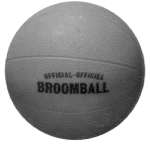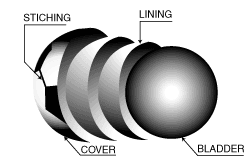|
It may appear simple enough in design, but
the amount of physics put into the ball used in broomball
is astounding. It works so simply but can be broken down into
complex layers. (Image courtesy of http://www.marchants.com/e-broomball.html)

The broomball ball can be made two ways. One
is a hard rubber ball which is not popular for obvious reasons.
The second and most popular way is to have construction like
a soccer ball. The ball has an inner gut which compress and
absorbs energy to spring back better off of the stick allowing
to to travel further when less force is applied.
(Image courtesy of http://www.fogdog.com)

Although the above picture is that of a soccer
ball, the construction is very similar, just scaled down.
It may be easier to understand how the inner
gut helps the ball travel further if we think of another example.
When playing tennis or badminton one wants to have tight strings,
but not too tight. One wants to achieve a balance where the
ball deforms just enough so that it has a lot of potential
energy, but not so much that the metal part of the racquet
takes some of that energy away. The same is true in broomball.
The heads of the sticks are hard, but the dual layers and
the inner gut allow the ball to be compressed just the right
amount so that it can reach speeds of up to 84 Mph (the world
record).
The energy transfer my look like this.

A point often over looked when shooting the
ball is that smaller surface area means more force per inch
which means more compression of the ball, which give a faster
velocity. If one uses the edge of the broomball stick head
instead of the flat wide side, faster speeds can be achieved.
Although the ball may seem simple at first
I hope the reader now understands how a little physics can
go a long way in the design of objects that seem simple to
us, such as a ball.
|


